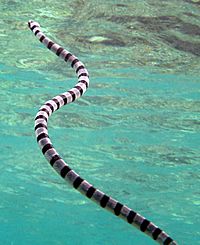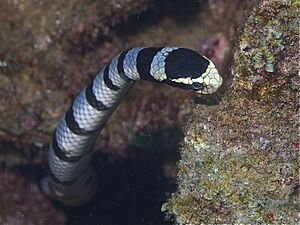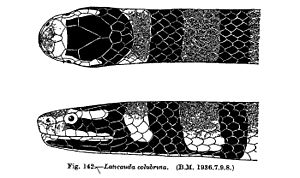Yellow-lipped sea krait facts for kids
The yellow-lipped sea krait (Laticauda colubrina) is a type of sea snake. You can find it in the warm, tropical waters of the Indo-Pacific ocean. People also call it the "banded sea krait" or the "colubrine sea krait".
Quick facts for kids Yellow-lipped sea krait |
|
|---|---|
 |
|
| A yellow-lipped sea krait in Wakatobi National Park, Indonesia. | |
| Scientific classification | |
| Kingdom: | |
| Phylum: | |
| Subphylum: | |
| Class: | |
| Order: | |
| Suborder: | |
| Family: | |
| Subfamily: | |
| Genus: |
Laticauda
|
| Species: |
Laticauda colubrina
|
Contents
About the Yellow-Lipped Sea Krait
Female yellow-lipped sea kraits are bigger than males. Females can grow up to 1.6 meters long. Males usually reach about 1 meter in length.
These snakes are light or dark bluish-grey on top. Their bellies are yellow. They have black bands all along their body and tail. The tip of their snout and their upper lip are yellow, which is how they got their name. The rest of their head is black.
Yellow-lipped sea kraits are very venomous. However, they are not aggressive. They rarely bite divers or swimmers.
How Sea Kraits Live
Yellow-lipped sea kraits spend time both in water and on land. Young snakes stay near the water and coasts. Adult snakes can travel further inland. They spend about half their time on land and half in the ocean.
Male adults move more on land when they are looking for mates. They also hunt in shallower water. This means they need to be good at moving on land. Female adults are less active on land during mating season. They hunt in deeper water, so they need to be better at swimming. Males are smaller, so they can crawl and swim faster than females.
These snakes have special body parts that help them swim. Their tail is flat like a paddle. Other sea snakes also have these features. But these adaptations make it harder for them to move on land. A yellow-lipped sea krait can still move on dry land. But it is much slower than when it swims. Most other sea snakes can barely move on land at all.
When they hunt, yellow-lipped sea kraits often go far from land into deep water. But they come back to land to digest their food. They also return to land to shed their skin and lay eggs. These snakes usually go back to their own home islands. Scientists moved some kraits to different islands. But the snakes found their way back to their home islands.
Yellow-lipped sea kraits found near Borneo sometimes have many ticks.
Hunting and Diet
Yellow-lipped sea kraits often hunt alone. But they can also hunt in large groups. They sometimes join hunting parties of giant trevally and goatfish. This is a team effort, like how moray eels hunt.
The sea kraits push small animals out of tight spots and holes. The trevally and goatfish then eat the animals that try to escape. When kraits are poking their heads into cracks, they cannot see predators coming. But they can trick bigger fish, sharks, and birds. They make their tail look like their head. The tail's color and movements are very similar to the head.
Yellow-lipped sea kraits mainly eat different types of eels. They also eat small fish. Males and females hunt differently. Females are much larger than males. They prefer to hunt in deeper water for bigger conger eels. Males hunt in shallower water for smaller moray eels. Females usually catch only one prey item per hunt. Males often catch several. After hunting, the kraits return to land to digest their food.
Reproduction and Life Cycle
The yellow-lipped sea krait lays eggs. This means it is an oviparous animal. The eggs develop outside the mother's body.
Every year, during the warmer months (September to December), males gather. They meet on land and in the water where the shore slopes gently. When a male finds a female, he chases her. Then, they begin their courtship.
Female yellow-lipped sea kraits lay up to 10 eggs at a time. They hide their eggs in cracks and crevices. The eggs stay there until they hatch. It is very rare to find these eggs in the wild. Only two nests have ever been officially reported.
How Sea Kraits Interact with Humans
Yellow-lipped sea kraits spend a lot of time on land. Because of this, people often see them. They are sometimes found inside the water pipes of boats. They are also attracted to light. Bright lights from hotels or other buildings on the coast can distract them.
This snake bites humans less often than other venomous snakes like cobras. This is because they are not aggressive. They usually try to avoid people. If they do bite, it is usually when someone accidentally grabs them. Most sea snake bites happen when fishermen try to untangle the snakes from their fishing nets.
In the Philippines, people catch yellow-lipped sea kraits for their skin and meat. The meat is smoked. It is then sent to Japan to be used in Japanese cuisine. The smoked meat of a similar snake, the black-banded sea krait, is used in Okinawan cuisine. It is used to make a soup called irabu-jiru.
Venom
The venom of a yellow-lipped sea krait affects the muscles and nerves. It is very powerful. Some say it is 10 times stronger than a rattlesnake's venom. In just one bite, a yellow-lipped sea krait can deliver enough venom to kill more than 12 humans. But they do not see humans as food or a threat. So, they avoid swimmers and divers and rarely bite them.
Images for kids
-
A yellow-lipped sea krait in Wakatobi National Park, Indonesia.
See also
 In Spanish: Serpiente marina de hocico ancho para niños
In Spanish: Serpiente marina de hocico ancho para niños




